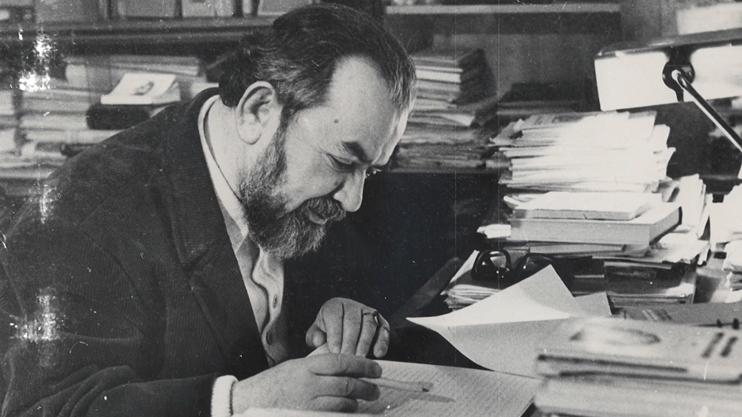Այս տարի Գէորգ Էմինի ծննդեան հարիւրամեակն է։ Ան հանդիսացած է 20րդ դարու երկրորդ կէսի Հայաստանի բանաստեղծութեան կարեւոր անուններէն մէկր՝ Եղիշէ Չարենցի մահէն ետք, Համօ Սահեանի, Յովհաննէս Շիրազի, Սիլվա Կապուտիկեանի, Հրաչեայ Յովհաննիսեանի եւ մանաւանդ՝ Պարոյր Սեւակի կողքին։
Աւազանի անունով՝ Գէորգ Մուրադեան, ծնած է 30 Սեպտեմբեր, 1919ին, Աշտարակ քաղաքին մէջ։ 1930ական թուականներուն, «կոմունիստական մկրտութիւններ»ու ժամանակ, ստիպուած է Կառլեն անունը որդեգրել։ 1940ին աւարտած է Երեւանի Կ. Մարքսի անուան պոլիտեխնինկական ինստիտուտի (այժմ՝ Հայաստանի պետական ճարտարագիտական համալսարան) ջրային թեքնիքի բաժինը։ Սակայն, շուտով անցած է գրականութեան կալուածը։ Նոյն տարին, լոյս ընծայած է իր երեխայրիքը՝ «Նախաշաւիղ» հատորը, զոր ստորագրած է Գէորգ Էմին անունով։ 1940-1942ին աշխատած է Մատենադարանին եւ Վարդենիսի շրջանին մէջ։ 1942-1944ին զինուորագրուած է ու մասնակցած՝ Բ. Աշխարհամարտին, ուր եւ վիրաւորուած է։
1949-1950ին Գ. Էմին մեկնած է Մոսկուա, ուր ուսանած է գրականութեան հիմնարկին կից հայ գրողներու աշխատանոցին մէջ։ Վերադառնալով Հայաստան, Մոսկուայի գրական շաբաթաթերթ «Լիտերատուրնայա Գազետա»յի երեւանեան թղթակիցը եղած է 1951-1954ին։ 1951ին ստացած է Խորհրդային Միութեան պետական մրցանակը «Նոր ճանապարհ» հաւաքածոյին համար, որ լոյս տեսած էր երկու տարի առաջ։ 1954ին դարձեալ մեկնած է Մոսկուա, ուր մինչեւ 1956 հետեւած է Խորհրդային Միութեան Գրողներու Միութեան կից բարձրագոյն գրական դասընթացքներուն։
Ստալինեան տարիներուն, Էմին սկսած էր իր սեփական ձայնը գտնել՝ հակառակ գաղափարական սահմանափակումներուն եւ քննադատութիւններուն։ Անոր բանաստեղծութիւնը, ուր մարդկութեան, հայ ժողովուրդի եւ հայրենիքի մասին մտորումները յօրինումի աւելի ազատ ոճով կ՚արտայայտուէին, 1960ական թուականներէն արժանացան գրաքննադատներու յատուկ ուշադրութեան։ 1968-1972ին Գ. Էմին Հայաստանի Գրողներու Միութեան ռուսերէն պաշտօնաթերթին՝ «Լիտերատուրնայա Արմենիա» ամսագրի գլխաւոր խմբագիր եղած է։ Այնուհետեւ, իբրեւ աւագ գիտաշխատող աշխատած է Հայաստանի Գիտութիւններու Ակադեմիայի Արուեստի հիմնարկին մէջ։ 1976ին երկրորդ անգամ արժանացած է Խորհրդային Միութեան պետական մրցանակին՝ «Հող, սէր, դար» ժողովածուին համար, իսկ 1979ին ստացած է «Չարենց» մրցանակը Հայաստանի մէջ։
Բանաստեղծական մնայուն արտադրած կողքին, որ ամփոփուած է շուրջ երկու տասնեակ հատորներու մէջ, Գէորգ Էմին նաեւ փորձագրութիւններու եւ ակնարկներու բեղուն հեղինակ է, որոնք նոյնպէս լոյս տեսած են քանի մը հատորներով, որոնցմէ ամենէն ժողովրդականը «Եօթը երգ Հայաստանի մասին»ն է (1974)։ Վերջինը բխած է 1967ի Գրիգոր Մելիք-Աւագեանի համանուն վաւերագրական ֆիլմէն, որուն բեմագիրը գրած է բանաստեղծը, եւ որ շահած է մրցանակներ Երեւանի եւ Լենինկրատի (Ս. Փեթերսպուրկ) մէջ։ Գէորգ Էմին եղած է բեղուն թարգմանիչը եւ իր լաւագոյն գործերը ամփոփուած են «Գիրք թարգմանութեանց» (1984) հատորին մէջ։ Միաժամանակ, անոր բանաստեղծութիւնները թարգմանուած են բազմաթիւ լեզուներով, ներառեալ՝ անգլերէնով (1988)։
Էմին ոչ-յարմարող ու ըմբոստ նկարագրով գրագէտ մը եղած է, որ 1988էն սկսեալ իր փորձագրութիւններով վեր հանած է խորհրդային անցեալի մինչ այդ թաքուն էջեր։ Ան իր մահկանացուն կնքած է 11 Յունիս 1998ին, 78 տարեկանին։


